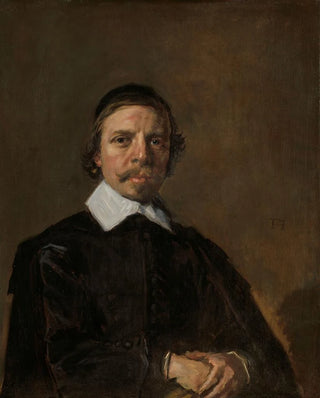Art print Portrait of a man, perhaps a clergyman - Frans Hals | Art print


View from behind

Frame (optional)
Portrait Art print of a man, perhaps a clergyman - Frans Hals – Captivating introduction
The "Portrait of a man, perhaps a clergyman" by Frans Hals is a work that transcends the simple framework of a traditional portrait. This iconic piece, created in the 17th century, demonstrates the artist's virtuosity in depicting human emotions and subtle character nuances. As viewers contemplate this artwork, they are immediately immersed in the universe of a man whose gaze seems to carry the weight of a life full of reflections and mysteries. The facial features, carefully modeled, evoke a psychological depth that invites contemplation. This portrait does not merely capture an image; it tells a story, that of an individual who could be a clergyman, but whose identity remains enigmatic, leaving room for imagination.
Style and uniqueness of the work
Frans Hals is renowned for his bold and expressive painting technique, and this piece is no exception. The way he uses light and shadow to create volume and depth is remarkable. The brushstrokes, both swift and precise, give a dynamic quality to the painting, making the character almost alive. The colors, though dark, are enhanced by touches of light that accentuate the details of the face and clothing. The neutral background highlights the subject, allowing the viewer to focus on the delicate features and facial expression. This ability to capture the very essence of the individual, through a rich palette and masterful execution, is what sets Hals apart from his contemporaries. The artwork evokes not only a physical presence but also an atmosphere imbued with gravity and dignity.
The artist and his influence
Frans Hals, an emblematic figure of the Dutch Golden Age, managed to leave his mark on his era with his innovative approach to portraiture. Active in Haarlem, he developed a style that influenced many artists, both of his time and subsequent generations. His ability to render human emotions with such authenticity inspired masters like Rembrandt and Vermeer. Hals was not content with merely reproducing faces; he sought to capture the soul of his subjects, to translate their thoughts

Matte finish

View from behind

Frame (optional)
Portrait Art print of a man, perhaps a clergyman - Frans Hals – Captivating introduction
The "Portrait of a man, perhaps a clergyman" by Frans Hals is a work that transcends the simple framework of a traditional portrait. This iconic piece, created in the 17th century, demonstrates the artist's virtuosity in depicting human emotions and subtle character nuances. As viewers contemplate this artwork, they are immediately immersed in the universe of a man whose gaze seems to carry the weight of a life full of reflections and mysteries. The facial features, carefully modeled, evoke a psychological depth that invites contemplation. This portrait does not merely capture an image; it tells a story, that of an individual who could be a clergyman, but whose identity remains enigmatic, leaving room for imagination.
Style and uniqueness of the work
Frans Hals is renowned for his bold and expressive painting technique, and this piece is no exception. The way he uses light and shadow to create volume and depth is remarkable. The brushstrokes, both swift and precise, give a dynamic quality to the painting, making the character almost alive. The colors, though dark, are enhanced by touches of light that accentuate the details of the face and clothing. The neutral background highlights the subject, allowing the viewer to focus on the delicate features and facial expression. This ability to capture the very essence of the individual, through a rich palette and masterful execution, is what sets Hals apart from his contemporaries. The artwork evokes not only a physical presence but also an atmosphere imbued with gravity and dignity.
The artist and his influence
Frans Hals, an emblematic figure of the Dutch Golden Age, managed to leave his mark on his era with his innovative approach to portraiture. Active in Haarlem, he developed a style that influenced many artists, both of his time and subsequent generations. His ability to render human emotions with such authenticity inspired masters like Rembrandt and Vermeer. Hals was not content with merely reproducing faces; he sought to capture the soul of his subjects, to translate their thoughts
12,34 €






